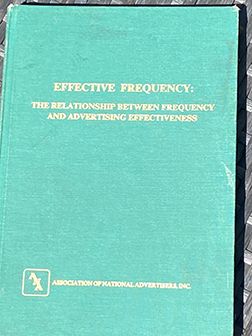By Walter Sabo
Consultant, Sabo Media Partners
A.K.A. Walter M. Sterling
Radio Host, “Sterling On Sunday”
Talk Media Network
 Growing a brand is a memory game. Which message will a target consumer value, remember it and take it to the cash register? The answer is not complicated but it is complex.
Growing a brand is a memory game. Which message will a target consumer value, remember it and take it to the cash register? The answer is not complicated but it is complex.
A great amount of energy and brain power goes into brand names, logo design, show topics but very little study is made of how often a company should deliver information to their target. The answer to the question of “how often” is critical to landing marks in the Nielsen diary, seeking for your station online or in-car. Effective frequency is essential to everyone’s success!
“When you’re sick of the song, that’s when the listener is just hearing it…” is about all the science any of us have been tutored in on the subject of effective frequency.
about all the science any of us have been tutored in on the subject of effective frequency.
Frequency of message has, in fact, been studied for over 100 years and the answers are astonishing! The most important, useful frequency of message studies are in the book, Effective Frequency: The Relationship Between Frequency and Advertising Effectiveness.
I bought the book in 1981 to find answers to how much external advertising does a station need to win (remember?)… how often to rotate a song promo or topic? The answers are not found in myth and legends but in hard studies conducted by companies such as Lever Brothers and Procter & Gamble.
The book was assembled by the Association of National Advertisers. It is a collection of landmark major studies on how memory is Impacted by the frequency of message exposure. Expertise on the workings of memory is obviously the most important knowledge in a Nielsen diary market and vital to growth in metered markets if a station has been starved of a promotion budget. This book was edited by the head of research for Lever Brothers, Michael J. Naples.
The next three Sabo Sez columns will highlight more actionable data from the book. For example, the studies in the book offer hard data about on how many spots your listener can tolerate, how often to state and restate the topic, phone number, your name and more. This book has, by far, offered my work the most powerful guidance of any source.
Here are a few facts you might be able to put to use right now:
1. The first and last spot in a cluster enjoys the greatest recall. Promos work equally well in either position. Spots placed first and last should be charged more.
2. Moving money out of a TV campaign and putting it into a radio campaign will neither diminish nor improve response. BUT holding the money in a TV campaign and adding money for a radio campaign will improve response.
3. Stunning: For many product categories, daypart significantly impacts the likelihood of conversion to sales. Food product commercials, according to an Ogilvy & Mather study, convert to sales significantly better in late night, fringe time than in daytime. In fact, food product ads in prime time have a negative impact on sales.
4. Properly conducted research for consumer goods products can be successfully applied to media content development.
Walter Sabo has been a C Suite action partner for companies such as SiriusXM, Hearst, Press Broadcasting, Gannett, RKO General and many other leading media outlets. His company HITVIEWS, in 2007, was the first to identify and monetize video influencers. HITVIEWS clients included Pepsi, FOX TV, Timberland, Microsoft, and CBS Television. He can be reached at walter@sabomedia.com and www.waltersterlingshow.com. “Sterling On Sunday,” from Talk Media Network airs 10:00 pm-1:00 ET, now in its 10th year of success.
Share this with your network
 Advertiser Perceptions surveyed 301 marketers and media agencies on the sales generated by each of the five sales drivers and as they have for the past six surveys, those surveyed had an average % of perception of creative’s contribution toward driving sales around 20%. But the reality according to one study is that creative’s contribution toward driving sales is actually about 49%. Quatical principle Marc Binkley says, “Creative is the closest thing we have to a silver bullet… it’s a way to supercharge budgets. Emotional, well-branded creative is a way to be more memorable. The goal isn’t just awareness, it’s being memorable in as many buying situations as possible.” See the complete blog post here.
Advertiser Perceptions surveyed 301 marketers and media agencies on the sales generated by each of the five sales drivers and as they have for the past six surveys, those surveyed had an average % of perception of creative’s contribution toward driving sales around 20%. But the reality according to one study is that creative’s contribution toward driving sales is actually about 49%. Quatical principle Marc Binkley says, “Creative is the closest thing we have to a silver bullet… it’s a way to supercharge budgets. Emotional, well-branded creative is a way to be more memorable. The goal isn’t just awareness, it’s being memorable in as many buying situations as possible.” See the complete blog post here. 


 Growing a brand is a memory game. Which message will a target consumer value, remember it and take it to the cash register? The answer is not complicated but it is complex.
Growing a brand is a memory game. Which message will a target consumer value, remember it and take it to the cash register? The answer is not complicated but it is complex. about all the science any of us have been tutored in on the subject of effective frequency.
about all the science any of us have been tutored in on the subject of effective frequency. Consultant Gary Begin of Sound Advantage Media writes today in a piece for TALKERS magazine in which he says that quite often there is a disconnect between the brand of a radio station and the brand-supporting messages that the sales staff is presenting to prospects. He says, “Experts in branding seem to be coming around to the idea that the power to make or break your brand-building effort lies not in the quality of your advertising but in the customer’s experience at the point of sale. In radio, that’s your over-the-air product and how your ad rep handles the advertiser.” He adds, “To navigate and successfully cross No Brand’s Land effectively, marketers must start by adapting brand message creation and delivery to today’s strategic sales processes.” He says there are two trends that will drive marketers’ efforts to create brand-supporting content that helps salespeople sell.”
Consultant Gary Begin of Sound Advantage Media writes today in a piece for TALKERS magazine in which he says that quite often there is a disconnect between the brand of a radio station and the brand-supporting messages that the sales staff is presenting to prospects. He says, “Experts in branding seem to be coming around to the idea that the power to make or break your brand-building effort lies not in the quality of your advertising but in the customer’s experience at the point of sale. In radio, that’s your over-the-air product and how your ad rep handles the advertiser.” He adds, “To navigate and successfully cross No Brand’s Land effectively, marketers must start by adapting brand message creation and delivery to today’s strategic sales processes.” He says there are two trends that will drive marketers’ efforts to create brand-supporting content that helps salespeople sell.” 